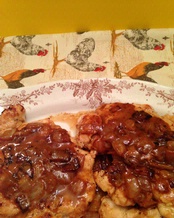|
|
 |

Sep 16, 2014
WINE WITH…Chicken Collops with Onions and Whiskey
With Scotland's referendum on independence in the news a lot, we were inspired to cook a traditional Scottish dish. No, not haggis. We dined on collops, an old culinary term that may be related to a Scandinavian one or perhaps to the French “escalope,” meaning a slice of meat or poultry pounded thin and sautéed. Whatever the true etymology, we decided to use chicken rather than veal or pork because we were drawn to the challenge of preparing chicken breasts that weren’t dried out and tasteless. We also wanted a dish that would be delicious with a variety of different wines. Along the way, as we tested the results, we discovered that a wee dram of whisky added to the pan juices contributes rich and complex flavors. related to a Scandinavian one or perhaps to the French “escalope,” meaning a slice of meat or poultry pounded thin and sautéed. Whatever the true etymology, we decided to use chicken rather than veal or pork because we were drawn to the challenge of preparing chicken breasts that weren’t dried out and tasteless. We also wanted a dish that would be delicious with a variety of different wines. Along the way, as we tested the results, we discovered that a wee dram of whisky added to the pan juices contributes rich and complex flavors.
Chicken Collops with Onions and Whisky
Serves 4
Pounding the meat flat tenderizes it by breaking down the fibers, and also allows it to be quickly cooked, thereby sealing in juices and flavor.
2-4 skinless, boneless chicken breasts, about 1½ pounds total
2 tablespoons olive oil (divided use)
1 teaspoon finely shredded lemon peel
1 medium onion, chopped
2 tablespoons butter
salt and pepper
3 tablespoons Scotch whisky
2 tablespoons whipping cream
If the chicken breasts are large, cut them in individual serving sized pieces. Using a mallet, rolling pin or even the edges of a sturdy plate, pound the pieces of chicken between sheets of waxed paper or cling wrap until they are about ½ inch thick. Place them on a plate or in a shallow bowl and drizzle with 1 tablespoon of the olive oil. Sprinkle the lemon peel over them. (If possible this step should be done an hour or two before cooking.)
Heat the remaining tablespoon of oil in a large, sturdy skillet. Add the onion and cook over medium-to-medium-high heat, stirring frequently, until the onions are very soft and have browned (but not burned). Add the butter to the pan, and when it is foamy add the chicken breasts in a single layer. Cook for two to three minutes, then turn them over and cook on the other side, spooning the onions over them as they cook. When the chicken is just cooked through (cut into a piece to make sure there is no trace of pink left), remove them to a platter. Pour the whisky into the pan, then stir in the cream. Continue cooking over medium high heat, stirring constantly, until the sauce has thickened and is a rich brown color. Spoon it over the chicken and immediately.
* * *
We found that reds and whites worked equally well with these collops, but that the key to a successful match was to choose a wine that is legitimately dry and has a hint of earthiness or minerality. The whisky gives the sauce a nutty edge, and the wine needs to complement rather than clash with it.
Selection
|
Approx. Price
|
Comments
|
Campos de Celtas, Rias Baixas (Spain) Albarino 2012
(Imported by Bacchus Importers)
|
$17
|
With just enough heft and body to make for a successful pairing, this wine’s waxy texture echoed the sauce in the dish. It also had the advantage of being truly dry on the palate.
|
Chapoutier, Côtes –du-Rhône (France) “Belleruche” 2011
(Imported by Terlato Wines International)
|
$13
|
A blend of Grenache (60%) and Syrah (40%), this warm, comforting red hit all the right notes. Its earthy notes, characteristic of good wines from the Rhône Valley, meshed beautifully with the dish.
|
Borgo Scopeto, Chianti Classico (Italy) 2012
(Imported by Vineyard Brands)
|
$20
|
This wine’s dusty undertone not only gives it complexity but also was what it such a good companion to our collops. It echoed the whisky and the onions.
|
J Vineyards and Winery, California (USA) Pinot Gris 2013
|
$16
|
J’s Pinot Gris used to more complete and complex, but the wine is still quite tasty. It performed extremely well in this pairing, its autumnal fruit flavors and rich texture complementing the rich sauce.
|
Robert Mondavi, Napa Valley (California) Chardonnay 2011
|
$26
|
A delicious northern California Chardonnay, this wine is beautifully balanced, with a firm acidic structure that reigns in its rich, ripe fruit flavors. Adding to the excitement, there is even the suggestion of a Burgundy-like minerality in the finish. It was a standout partner for the collops.
|
|
 |
|